Sandblasting on the mirror: application and care
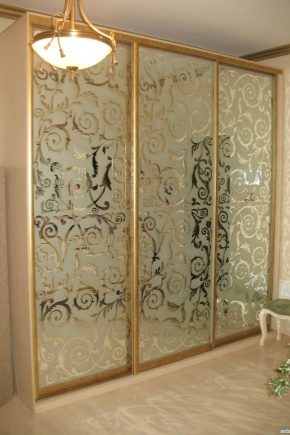
A mirror is sometimes a mystical piece of furniture, the scope of which is undeservedly narrowed. Mirrored surfaces are able to expand boundaries, create the illusion of whimsical textures and play of light. After all, a mirror is not only a mandatory attribute in the arsenal of every woman, a functional unit of a bathroom or a lonely hanging part of a hallway, it is an opportunity to create your own looking glass, an environment that meets your character and needs.

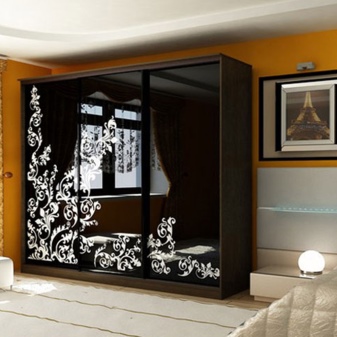
Today, giving a mirror an unusual shape or decorating it with an interesting frame is by no means the whole range of designers' ideas. Drawing on the glass surface with the help of sandblasting technologies is very effective.
Peculiarities
Sandblasting is not only a chance to create a unique decorative element, but also a whole work of art. The mirror surface, processed using this technique, expands the space, gives a feeling of lightness and weightlessness, without losing its original purpose.
Sandblasting a mirror area is an amazing opportunity to make any interior stylish, unique and at the same time practical.

The scope of such decorative elements is huge:
- paintings, panels, mirrors;
- furniture facades, wardrobes, kitchen aprons;
- tabletops of coffee, coffee and dining tables;
- ceilings;
- interior doors and partitions, doors of shower cabins and saunas;
- balcony and stair railings.





If you decide to use this design option for your space, you should note its many advantages:
- relatively low cost in relation to showiness;
- efficiency of manufacturing;
- resistance to external influences;
- ease of maintenance and operation;
- the accuracy of transferring any shapes and penumbra;
- the ability to design any areas;
- imparting texture to the drawing due to multilevel processing;
- the option of applying the pattern on the inside of the mirror is preserved, leaving the outside completely smooth.

Images do not fade, do not crumble, have moisture resistance, can be placed in any area of your apartment.
Varieties
Currently, the technology of the sandblasting method includes several design principles:
- Reflective area with frosted image. The mirror surface itself is not painted over; you can look at such an object of the room's decoration. Only the stencil itself is matted.
- On a matte background, a mirrored silhouette. From the point of view of functionality - not the best visualization. The display plane is too small, the pieces are often scattered.
- Bronze with sandblasting. Colors can be added to a reflective object; for this, glass coloring is used during production or when applying a mirror layer. Nowadays, you can get a mirror image of any shade. White and bronze colors are in the greatest demand - they are neutral and suitable for many interior colors. Products are wear-resistant, durable, have excellent glare and therefore are successfully used in the decoration of both residential and office buildings.



- Matting the entire perimeter with relief priorities. The surface does not reflect at all, the supply of sandy abrasive is made with a different intensity. As a result, some details are highlighted.
- Deep impact.The illusion of volume is created on the mirror due to the multi-layered work.
There are also such interesting processing techniques as color and luminescent sandblasting. The first is characterized by the addition of bright accents to the main stencil. For the second - the use of a special substance that accumulates light during the day, remaining dull when illuminated. The trick lies in the fact that the outlines of the drawing become clearly visible only in the dark and retain their glow for several hours.

In addition, the same element applied from different sides of the surface will have a different effect. If the decoration is applied to the outer level, it will, as it were, be doubled, reflected. The pattern placed from the inside turns out to be placed in the very thickness of the reflection. With the organization of the correct lighting, such a masterpiece acquires bizarre "special effects".
Popular images
Today, the sandblasting principle of applying abrasives can be found not only in personal apartments, but also in offices, retail spaces, and public places. If this is a workspace, then the illustrations are made in accordance with the activities of the company, reflect the logos or slogans. The interiors with the listed options are quite progressive, fashionable and are gaining an increasing audience of fans.


The considered design method is capable of revealing any style, for example:
- Classical. The patterns are laconic, the contours are clear, symmetrical and proportional.
- High tech. Drawings of simple shapes, outlined edges, add up to understandable ensembles.
- Modern. Ornate shapes, rounded corners and intertwined wavy lines.
- Country. A huge variety of flowers and floral arrangements, vegetation, animals and birds. The motives of rustic simplicity are pleasing to the eye, comfortable.
- Ethnos. For areas designed in this way, it is necessary to have supportive furnishings that emphasize traditional features. For China - tiger, reptiles, hieroglyphs, bamboo, pagoda; for Egypt - unusual bas-reliefs in which you can add blotches of color; for the subtle world of the East - intricate arabesques.
- Art Deco. Graceful, light strokes, luxurious, rich, perfectly traced textured ensembles, the exact opposite of minimalism.





For any room, there are unspoken rules for choosing a decor:
- For the hall, you can choose a wide frame, landscape, urban sketches.
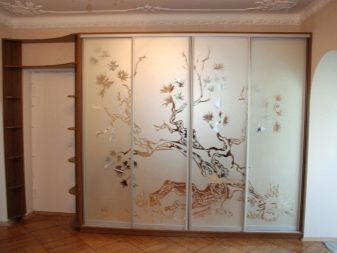

- For the living room, which is the face of the house, you can choose landscape sketches, vignettes, rosettes. Everything will depend on the general concept of the premises.

- The hall is designed for receiving guests, holding banquets. The more reflective zones, the more solemn the atmosphere will appear. Perfect fit: oriental openwork, various ornaments, figures of simple geometry - squares, rhombuses, circles. You can count a myriad of different options.

- Bedroom. Mirrors here are not only decorative, but also functional. Monument and pomp will be out of place. More suitable are single specimens of living or fabulous creatures, plants, plot sketches, abstract patterns.


- Children's. The selection is strictly individual for the age and interests of the child. These can be your favorite characters from fairy tales and cartoons, as well as silhouettes of toys, animals, flowers, sweets. It is a good idea to place a height meter. You can provide a backlight, then the mirror will acquire another additional function - a night light.

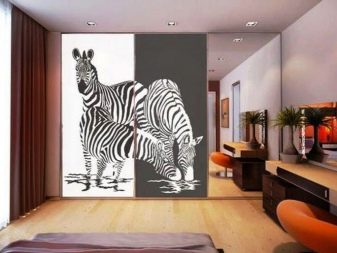
- Bathroom. An indispensable element for decorating this space will turn into a real masterpiece if it is decorated with an abrasive coating in the form of sea inhabitants or underwater plants.

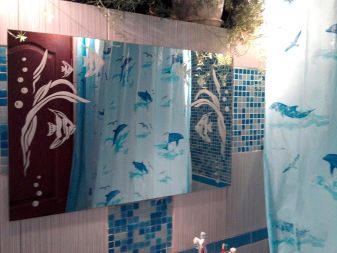
Note that since the sandblast is not afraid of moisture and ultraviolet radiation, it is safe to place it in high-risk areas.
How to apply?
It is quite understandable that such an unusual design object is gaining more and more popularity.The cost of work in specialized workshops is relatively low, but in today's crisis realities, even such costs run the risk of becoming an unbearable burden. Let's figure out how you can complete such a spectacular project on your own.
There are the following options for exposure to the surface:
- deep - recreating the volume and drawing the texture of illustrations;
- color - multi-colored and luminescent images;
- printed - modeling of an opaque velvety picture;
- engraved - the design of a well-developed rapport.



For an industrial method of applying sandblasting, you will need special equipment, which, of course, is inaccessible to a common man in the street. But there is always a way to create a similar masterpiece at home.
You can create several options for textures yourself:
- reflective with a matte pattern;
- matte with mirror elements;
- different levels of haze.
To implement our plan, you need to prepare:
- work surface;
- glue (preferably in the form of an aerosol);
- ready-made stencil with a picture (you can cut it yourself);
- matting paste (or quartz sand and a fine sieve, but then a sandblasting gun with a compressor may be needed);
- alcohol.

Stages of work:
- Degrease the working area with alcohol.
- Fix the stencil. If it is cut with your own hand, it will be more convenient to do it on adhesive paper, so that during the work there is no shift, and the contours are clear.
- Apply a thick layer of paste. It does not need to be saved, since when the mass is etched for fifteen minutes, it will be possible to remove its excess and use it again in the future. The remains of the paste are washed off under running water.
- If you decide to use a gun, the abrasive particles will mat the glass under the pressure of the air jet. The created effect will depend on their size - velvety or coarse-grained.
- The final step will be to carefully remove the stencil, wipe it with a dry cloth to give the work brightness and clarity.


Self-made decor will be original in any setting, so you should not deny yourself such a pleasant opportunity for self-realization and decorating your home space.
See the next video for more on this.
How to care?
Despite the stability of the drawings made in this technique, it is worth adhering to some recommendations for use and care:
- Delivery of mirrors at subzero ambient temperatures involves unpacking and removing them only on condition of preliminary daily storage in a warm room.
- After unpacking, the mats must not be inserted between the two sheets. Paper, plastic and other insulating materials are strongly discouraged. The best version of transportation would be to build a large furniture board or pyramid.
- The sides exposed to sandblasting cannot be stored facing each other. It is also worth excluding the possibility of covering the matte surface with a protective film. Before installation, it is better to store the mirror on special pyramids, or at least vertically against the wall.
- Contaminants from these planes are removed exclusively by liquid weakly alkaline compounds, the acidity level of which is close to neutral. It is possible to use slightly lathering agents, compounds based on neutral shampoos, in which the presence of an abrasive is not observed.
- The use implies the protection of mirrors from force effects, interaction with piercing and cutting objects, aggressive and abrasive compounds.
- It is not allowed to get fat-containing liquids and oils on the matted part of the mirrors.
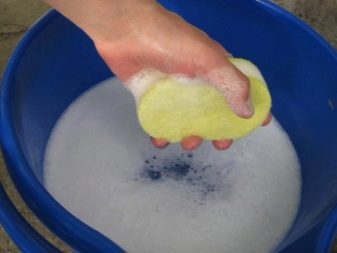

- It is strictly forbidden to use acetone-containing liquids, gasoline, white spirit, cleaning and washing powders, glass cleaning compounds for care.
- It is not recommended to take colored substances for processing.
- The compositions are applied to the object with a gentle foam sponge or cotton cloth, washed with plenty of water. It is allowed to take microfiber napkins.
- The use of synthetic and fleecy fabrics, colored rags is prohibited.
- These decorative elements are recommended to be placed mainly in closed rooms without temperature extremes, with a relative humidity of up to seventy percent.
Interesting samples
Thanks to fashion trends, many mirror companies quickly picked up the idea of creating spectacular mirror paintings using the sandblasting method discussed above. We suggest that you familiarize yourself with some of the original interior design options for the hallway, living room, bedroom, children's room, bathroom and other premises using such mirrors.


















The comment was sent successfully.